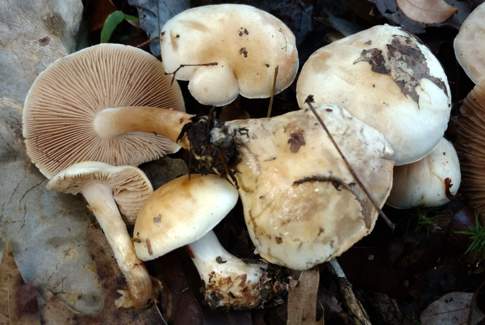 Hebeloma mackinawense (Photo: J. Kalichman)
Hebeloma mackinawense (Photo: J. Kalichman)Taxonomy
Full name: Hebeloma mackinawense Hesler & A.H. Sm., Sydowia 37: 282 (1984)Genus: Hebeloma
Section: Velutipes
Types: UNITED STATES: Michigan: Emmet, west of Mackinaw City (approx. 45.7742°N, 84.7458°W, alt. approx. 200 m a.s.l.) in mixed woodland, 16 Sep. 1950, H.D. Thiers, A.H. Smith (AHS35841), det: L.R. Hesler, A.H. Smith (Holotype. herbarium acc. no. MICH 10763, HJB1000419).
- arrow_drop_downarrow_drop_upEtymology
- arrow_drop_downarrow_drop_upOriginal diagnosisPileus 3-11 cm latus, convexus demum late convexus vel planus, glaber viscidus, pallide alutaceus, margine pallidior, aquoso-zonatus vel aquoso-maculatus. Lamellae pallido - brunneae deinde paene rufobrunneae, confertae, latae. Stipes albidus, deorsum brunnaccus, sursum squamulosus, Velum deest. Sporae 9-12 x 6-7.5 μm, dextrinoideae. Pleurocystidia 50-90 x 8-11 μm x 4-6 μm. Hypodermium nullum.
- arrow_drop_downarrow_drop_upEnglish translationPileus 3-11 cm broad, convex then broadly convex or applanate, glabrous, viscid, pale whitish-yellow, lighter on the margin, watery-zonate or watery-spotted. Lamellae pale brown finally almost reddish-brown, crowded, broad. Stipe whitish, downwards brownish, above squamulose. Veil none. Spores 9-12 x 6-7.5 μm, dextrinoid. Pleurocystidia 50-90 x 8-11 μm x 4-6 μm. Hypoderm none.
References
Description
- arrow_drop_downarrow_drop_upThresholds
Description of Hebeloma mackinawense based on 6 collections
- arrow_drop_downarrow_drop_upMacroscopic descriptionPileus: (29) 36–68 (110) mm diameter; shape often convex or broadly umbonate; characters often spotting; margin characters involute; viscosity tacky when moist; colour variation often unicolour or two color; colour at centre cinnamon.
Lamellae: attachment often adnexed or emarginate; maximum depth up to 5 mm; number of complete lamellae 74–92; presence of tears often absent or visible with x10 lens; white fimbriate edge present.
Cortina presence: no.
Stipe: (36) 54–83 (110) x (8) 10–14 (20) {median} x (10) 14–19 (25) {basal} mm; stipe Q 3.6–6.2; base shape bulbous; floccosity fibrillose or pruinose at apex; rooting no; thick rhizoids at base Not recorded;
Context: Texture firm; stipe interior stuffed; stipe flesh discolouring variable; slenderness measure 8.2–8.8; smell occasionally odourless or weakly raphanoid; taste often bitter or mild where recorded.
Spore deposit colour: Not recorded.
Exsiccata characters: Not recorded.
- arrow_drop_downarrow_drop_upMicroscopic descriptionSpores: shape amygdaloid, often limoniform; colour in microscope occasionally brown pale, yellow or yellow brown; guttules no. papilla often yes, occasionally weak; Spore Code: O2 O3; (P0) P1 (P2); D3 D4.
Basidia: 21–31 (32) x 7–9 μm; ave. Q 2.8–3.3; spore arrangement 4 spored;
Cheilocystidia: main shape cylindrical or ventricose, often lageniform, occasionally lanceolate; special features observed often septa, occasionally many collapsed in exsiccata; cheilocystidia ratios: A/M = 0.91–1.04; A/B = 0.58–0.71; B/M = 1.45–1.72.
Pleurocystidia: seen.
Ixocutis: epicutis thickness (measured from exsiccata) up to 120 μm; ixocutis hyphae width up to 7 μm; ixocutis hyphae encrustation no; shape of trama elements beneath subcutis often ellipsoid, isodiametric or thickly sausage-shaped up to 18 μm wide.
Caulocystidia: Similar to cheilocystidia but larger, up to 110 μm.
- arrow_drop_downarrow_drop_upSpore measurements
- arrow_drop_downarrow_drop_upCheilocystidia measurements
- arrow_drop_downarrow_drop_upHabitat and distributionHebeloma mackinawense's preferred habitat appears to be bog with boggy soil. Where only one possible associate was recorded, the most commonly recorded associate was Fagus (50.0%) but Picea (50.0%) were also recorded. In these cases the most commonly recorded families were Fagaceae (50.0%) and Pinaceae (50.0%). Overall the most commonly recorded families are Fagaceae (50.0%) and Pinaceae (50.0%) The growth habit of our collections was often caespitose, gregarious or scattered.
According to our current collections, the species is found only in Northern America. On the continent, collections have been found only in the temperate broadleaf & mixed forests WWF biome The World Wildlife Fund (WWF) have divided the world into 867 terrestrial ecoregions. The ecoregion here is estimated by mapping from the GPS coordinates of the collection using data made available by Dinerstein et al (2017). Use this webtool to explore the ecoregions visually or see a full list of current ecoregions on Wikipedia. (Appalachian-Blue Ridge forests (40.0%), Eastern Canadian Forest-Boreal transition (40.0%) and Western Great Lakes forests (20.0%) ecoregions). From collector information, it appears collections have been found in the 5.4 Wetlands (inland) – Bogs, marshes, swamps, fens, peatlands (33.3%), 14.5 Urban Areas (33.3%) and 1.4 Forest – Temperate (33.3%) IUCN habitats We map from the collector's description of the habitat to the International Union for Conservation of Nature (IUCN)'s definition using a standardised set of rules. Please see this page for a full list of IUCN habitats.. Within Northern America we have records from Southeastern U.S.A. (Tennessee), Eastern Canada (Ontario) and Northeastern U.S.A. (Indiana and Michigan).
Geographic distribution
Phenology
- arrow_drop_downarrow_drop_upAdditional cited collections